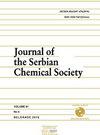废麻、废亚麻纤维与棉、棉/涤纱对废水中亚甲基蓝的吸附性能比较研究
IF 0.7
4区 化学
Q4 CHEMISTRY, MULTIDISCIPLINARY
引用次数: 0
摘要
利用纺织工业中大量的废弃大麻和亚麻纤维、棉花和棉/涤纶纱线作为廉价有效的吸附剂,去除废水中的亚甲基蓝。采用扫描电镜、傅里叶变换红外光谱、吸碘率、保水率、零电荷点以及结晶度指数和表面结晶度的测定等方法对废纤维和废纱线进行了表征。考察了接触时间、初始浓度、温度和pH值对亚甲基蓝吸附性能的影响。结果表明,棉和棉/涤纶纤维的结构越有序,其吸附量越低,符合拟二级动力学模型和Langmuir等温线模型;而亚麻和大麻纤维的结构越不均匀,其吸附量越高,符合拟一级动力学模型和Freundlich等温线模型。根据所获得的结果,废弃的木质纤维素纤维和纱线可以用于废水的变色,从而解决纺织工业产生的废物问题。本文章由计算机程序翻译,如有差异,请以英文原文为准。
Waste hemp and flax fibers and cotton and cotton/polyester yarns for removal of methylene blue from wastewater: Comparative study of adsorption properties
Waste hemp and flax fibers, and cotton and cotton/polyester yarns, available in large quantities from the textile industry, were used as cheap and effective sorbents for the removal of methylene blue from wastewater. Waste fibers and yarns were characterized by scanning electron microscopy, Fourier transform infrared spectroscopy, iodine sorption, water retention, and point of zero charge, as well as through the determination of crystallinity index and degree of surface crystallinity. Adsorption of methylene blue was optimized by examining the influence of contact time, initial concentration, temperature, and pH value. It was found that the more ordered structure of cotton and cotton/polyester yarns leads to lower adsorption capacities and better agreement with pseudo-second order kinetic and Langmuir isotherm model, while the more heterogeneous structure of flax and hemp fibers show higher capacities for methylene blue adsorption, better described by the pseudo-first order kinetic and Freundlich isotherm model. Based on the obtained results, waste lignocellulosic fibers and yarns can be utilized for the discoloration of wastewater, thereby solving the problem of waste generated in the textile industry.
求助全文
通过发布文献求助,成功后即可免费获取论文全文。
去求助
来源期刊
CiteScore
1.80
自引率
0.00%
发文量
76
审稿时长
1 months
期刊介绍:
The Journal of the Serbian Chemical Society -JSCS (formerly Glasnik Hemijskog društva Beograd) publishes articles original papers that have not been published previously, from the fields of fundamental and applied chemistry:
Theoretical Chemistry, Organic Chemistry, Biochemistry and Biotechnology, Food Chemistry, Technology and Engineering, Inorganic Chemistry, Polymers, Analytical Chemistry, Physical Chemistry, Spectroscopy, Electrochemistry, Thermodynamics, Chemical Engineering, Textile Engineering, Materials, Ceramics, Metallurgy, Geochemistry, Environmental Chemistry, History of and Education in Chemistry.

 求助内容:
求助内容: 应助结果提醒方式:
应助结果提醒方式:


